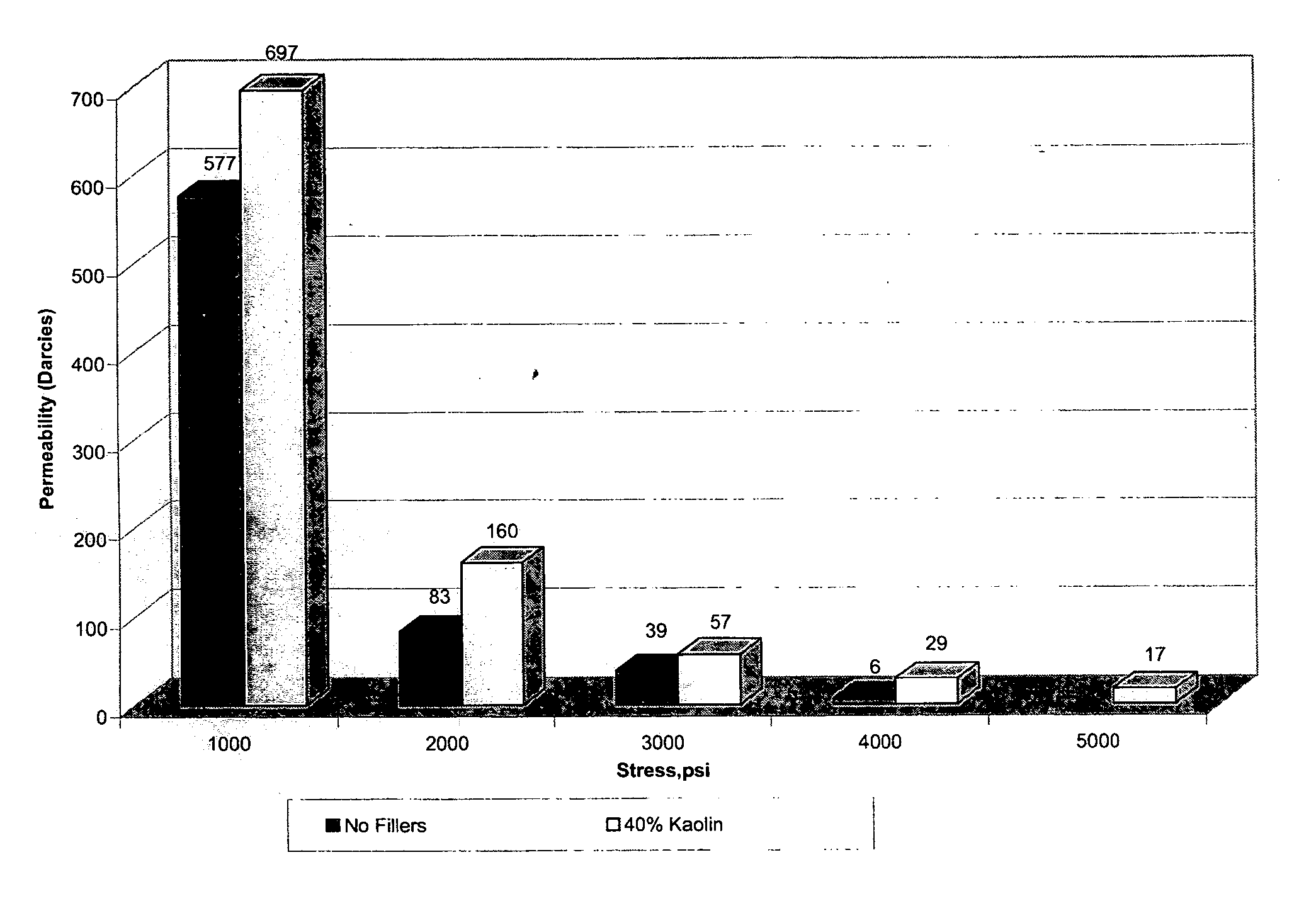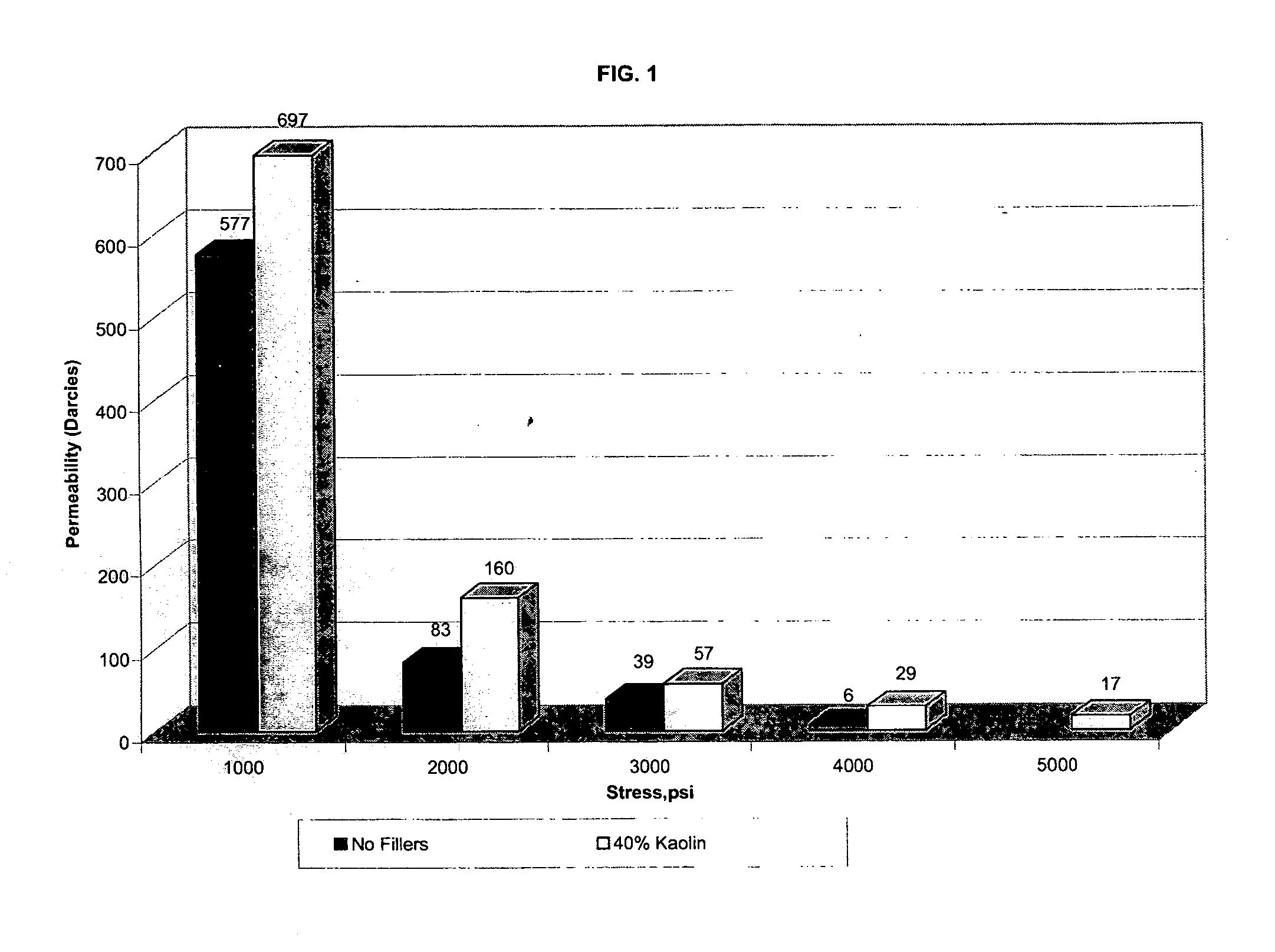Method of using lightweight polyamides in hydraulic fracturing and sand control operations
- Summary
- Abstract
- Description
- Claims
- Application Information
AI Technical Summary
Benefits of technology
Problems solved by technology
Method used
Image
Examples
example 1
[0052] A polyamide composite containing 40 weight percent kaolin was obtained from Rhodia Engineering Plastics. The ASG of the composite was 1.46 and the bulk density was 0.87 g / cc and the size was about a 36 / 60 mesh and the shape was substantially spherical.
[0053] Conductivity tests were performed according to a modified API RP 61 (1st Revision, Oct. 1, 1989) using an API conductivity cell with Ohio sandstone wafer side inserts to simulate the producing formation. A multilayer pack of the composite containing about 31.5 g of proppant was then loaded between the sealed sandstone wafers to increase the propped width. The proppant pack exhibited a density of about 1 lb / ft2.
[0054] The conductivity cell was then placed on a press while stress was applied at 100 psi / minute until the target temperature was reached. Fluid was then allowed to flow through the test pack maintaining Darcy flow. The differential pressure was measured across 5 inches of the pack using a “ROSEMOUNT” differenti...
example 2
[0057] Conductivity tests were performed on the composite of Example 1 according to the recited procedure at varying temperatures. Experimental parameters and results are shown in Table II below:
TABLE IIClosure Pressure (psi): 5000Fluid Pressure (psi): 500TimeTempClosureConductivityWidthPermeabilityHours° C.Psimd-ftmmdarcies024.410191749885.1110447065.51024381645.0323131065.21029240544.9814732064.91024227844.951402065.1509117934.011361064.8509611763.86932065.2509611233.8689074.550916393.76521079.450965293.73432079.550184803.73393079.550184723.73384079.550133853.73315079.650184483.73376079.650135023.73417079.350184233.7135093.550132333.68191093.650181733.68142093.450131923.68163093.550131683.68144093.450131863.68155093.550131693.68146093.750181803.68157093.750181653.6814
[0058] Table II illustrates high conductivity at increasing temperatures while stress is maintained at around 5,000 psi.
example 3
[0059] The polyamide composite of this Example was obtained from pilot run samples. The polyamide composite was prepared as set forth in Example 1 but on a production scale. A partial monolayer proppant pack was created by loading 1.3 grams of proppant as a pack between the sealed sandstone wafers. The proppant pack exhibited a loading of about 0.041 lb / ft2. Conductivity tests were then run as described in Example 1. Experimental parameters and results for the test are shown in Table III below:
TABLE IIIClosure Pressure (psi): 1000-6000Fluid Pressure (psi): 500TimeTempClosureConductivityWidthPermeabilityHours° C.Psimd-ftmmdarcies065.610734309041.0812138110113.010781014660.884349880110.02028375980.8841334910110.02028431360.8181607520110.22033430850.8001641324111.22024382250.782148930110.34018272100.6961191710109.84023191530.691845020109.24018171190.681766524110.24018174260.67678610110.46096104650.368866110110.3608613680.351118920110.4608612090.338109524109.9609111850.3231120
[0060] T...
PUM
| Property | Measurement | Unit |
|---|---|---|
| Percent by volume | aaaaa | aaaaa |
| Temperature | aaaaa | aaaaa |
| Temperature | aaaaa | aaaaa |
Abstract
Description
Claims
Application Information
 Login to View More
Login to View More - R&D
- Intellectual Property
- Life Sciences
- Materials
- Tech Scout
- Unparalleled Data Quality
- Higher Quality Content
- 60% Fewer Hallucinations
Browse by: Latest US Patents, China's latest patents, Technical Efficacy Thesaurus, Application Domain, Technology Topic, Popular Technical Reports.
© 2025 PatSnap. All rights reserved.Legal|Privacy policy|Modern Slavery Act Transparency Statement|Sitemap|About US| Contact US: help@patsnap.com


